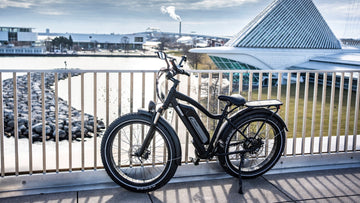As the seasons change, so do the environmental factors that can impact your e-bike battery. The hot summer sun and the cold winter temperatures can damage battery health. Storage habits during off-seasons are crucial in maintaining battery performance.

A well-maintained battery lasts longer, saving you money on costly replacements. It delivers the full power and range your e-bike was designed for, allowing you to ride easily and comfortably. Neglecting your battery can lead to safety hazards like overheating or malfunctioning. Proper care ensures your e-bike operates at its safest potential.
In this guide, you'll understand how your battery works, its key components, and the factors influencing its performance. We'll then guide you through diagnosing potential issues and equip you with practical strategies to revitalize and maintain your battery for optimal performance.
Understanding Your E-Bike Battery
Unlike the lead-acid batteries of yesteryear, the Himiway e-bike uses lithium-ion (Li-ion) batteries. These give you several advantages: lighter weight, higher energy density, and longer lifespans. Here are the inner workings of your e-bike battery:
-
Battery Cells:
The core building blocks of your battery are individual lithium-ion cells. These cells contain an anode (negative electrode), a cathode (positive electrode), and an electrolyte separating them. Lithium ions flow from the anode to the cathode during discharge, generating electricity that powers your e-bike motor. Recharging reverses this process, pushing the lithium ions back to the anode.
-
Battery Management System (BMS):
The BMS monitors parameters like voltage, current, and temperature within each cell. It ensures safe operation by preventing overcharging, over-discharging, and overheating. Additionally, the BMS balances the individual cells within the battery pack, ensuring all cells degrade similarly for optimal performance.
-
Battery Pack:
Individual lithium-ion cells are insufficient to power your e-bike. To power it, they are grouped electrically in series or parallel configurations, or a combination of both, to form a battery pack. Series connections increase the voltage output, while parallel connections increase the capacity. The specific configuration depends on the desired voltage and capacity for your e-bike.
Battery Specifications
Understanding your e-bike battery's key specifications helps you make informed decisions and optimize your riding experience. Here are the three most crucial factors:

-
Voltage:
Voltage is measured in volts (V) and represents the electrical pressure pushing current through the system. Higher-voltage batteries typically offer more power and higher top speeds for your e-bike. However, they may also be heavier and more expensive. The Himiway A7 Pro has a high-capacity 720Wh LG battery, 48V 15Ah, and is detachable. It is also built with durable 21700 Li-ion cells for extended range and performance. The specific voltage your e-bike requires depends on its motor and overall design.
-
Capacity:
Capacity, measured in ampere-hours (Ah), represents the total amount of electrical energy a battery can store. Think of it as the size of your e-bike's "fuel tank." A higher capacity battery translates to a longer potential range on a single charge. For instance, a 10Ah battery can deliver 10 amperes of current for 1 hour or 5 amperes for 2 hours. Your range depends on terrain, rider weight, and motor usage.
-
Discharge Rate:
The discharge rate, expressed as a "C" rating, indicates the maximum rate at which a battery can safely deliver its stored energy. For example, a 5Ah battery with a 1C discharge rate can provide a maximum continuous current of 5 amperes (5Ah x 1C). A higher C-rate allows the battery to handle higher motor demands for short bursts, potentially leading to quicker acceleration or climbing hills with ease. However, exceeding the C-rate rating can stress the battery and accelerate degradation.
Battery Degradation and Extending Lifespan
Like any mechanical device, e-bike batteries experience a natural degradation process over time. This means the battery's capacity to hold a charge gradually diminishes. Several factors contribute to this degradation:
-
Depth of Discharge:
The depth of discharge refers to how much of a battery's capacity is used during a single ride. Frequent deep discharges (using more than 80% of the battery's capacity) can accelerate degradation.
-
Extreme Temperatures:
High and low temperatures can stress the battery and reduce lifespan. Ideally, store your e-bike battery in a cool, dry place with moderate temperatures. Avoid leaving it in direct sunlight or extreme cold for extended periods.

-
Charging Habits:
Constantly leaving your battery on the charger, even after it's fully charged, can contribute to degradation. Additionally, using incompatible or fast chargers not designed for your specific battery can be detrimental.
Maintenance Tips for E-bike Battery
By understanding these factors and adopting good battery care practices, you can significantly slow down the degradation process and extend the lifespan of your e-bike battery. Here are some practical maintenance tips:
-
Maintain a Shallow Depth of Discharge and store rightly:
Avoid completely draining your battery whenever possible. Aim to recharge when it reaches around 20% capacity. This reduces stress on the battery and improves its long-term health. As mentioned earlier, extreme temperatures can shorten battery life. Store your e-bike battery in a cool, dry place with moderate temperatures. Avoid direct sunlight and freezing temperatures. If you aren't using your e-bike for an extended period (weeks or months), consider storing the battery partially charged (around 50%) and disconnecting it from the bike.
-
Use the Correct Charger and Minimize Time Spent at Extremes of Charge:
Always use your Himiway charger, which is specifically designed for your battery type and voltage. Avoid using generic or fast chargers that may not regulate voltage or current properly. Similarly, avoid leaving your battery plugged in for extended periods after fully charging. Ideally, store your battery somewhere between 20% and 80% charged for long-term storage.
Signs of a Failing E-bike Battery
While all e-bike batteries degrade over time, some telltale signs indicate a more significant issue and potential need for replacement. Be on the lookout for:
-
Reduced Range:
One of the most noticeable signs of a deteriorating battery is a decrease in the overall range of your e-bike. Initially, you might have been able to travel significant distances on a single charge. However, as the battery ages, you may find that the distance you can travel before recharging has significantly diminished. This reduced range can be frustrating, especially if you rely on your e-bike for longer commutes or rides.
-
Reduced Power Output:
Over time, you may notice that your e-bike's motor is not performing as efficiently as it used to. When climbing hills or accelerating from a standstill, the motor may feel sluggish and struggle to deliver the power needed. This reduced power output can make riding more challenging, requiring more effort to maintain the desired speed and performance.
-
Erratic Battery Meter:
-
Unusual Battery Behavior:
In addition to the above signs, other abnormal behaviors could indicate a failing battery. For instance, you may notice that the battery becomes excessively hot during charging or discharging cycles. Overheating can indicate internal issues and should be addressed promptly to avoid potential safety hazards. Another concerning sign is a bulging battery case, which suggests the internal components may be damaged or compromised. A bulging battery should be replaced immediately to prevent any risk of leakage or explosion.
Conclusion
Understanding your e-bike battery's technology, specifications, and degradation process helps you to make informed decisions and maximize its lifespan. Adopting good battery care practices like maintaining a shallow depth of discharge, using the correct charger, and properly storing your battery can keep your e-bike running strong for years.
Do not wait until issues arise to take proactive steps today to preserve your e-bike's battery health. Visit Himiway's website or consult with our customer support for more tips and guidance on maintaining your e-bike battery. Invest in proper maintenance and enjoy countless rides with confidence and peace of mind. Take action now, and ride on!




























